Business
An Inside Look Into Camden’s Newest Startup: Penji
Published
8 years agoon

Within the developing City of Camden, there are gems popping up in their business district. We sat down with Penji’s co-founder, Johnathan Grzybowski. In this conversation, we learned about the problem with design and what Penji is doing to resolve it.
Penji is a dependable on-demand design service that helps marketing teams receive custom design at an affordable monthly cost.
How did you come up with the idea of Penji?
It’s the culmination of our journey as a design agency and our desire provide jobs for students in Camden. Penji is a product we built from the ground up to give our customers a better experience working with a designer, meanwhile we focus on training and hiring students in Camden.
We believe our platform can give customers high quality design at a set monthly cost while giving internships, jobs, and opportunities to students within our community.
What does Penji mean?
Let’s just say that there are a lot of hints out there in the digital universe and we will leave it up to you to decide what you think Penji means.
What is the problem with design today?
The main problem with design is the “pick two” stigma in business. Typically, clients want affordability, quality, and speed, but never have all three.
For example, if you’re a startup looking to expand your marketing strategies, you’re stuck scouring the internet to find a high quality and affordable designer. So then you hire that designer, but you get your affordable and quality design delivered…late. In this instance, the problem is speed.
If you’re an established company, you’ll likely hire an expensive agency to deliver high quality design on time, however you’ll be paying an arm and a leg for it. The problem here is cost.
We believe that we are in an age where we can build just about anything we put our minds to, but the greatest differentiator we have in business is design. We shatter the pick two stigma by helping marketing teams to obtain cost-effective, quality design, on time – every time.
What is your mission?
We strive to be a community-conscious design platform that delivers an exceptional service while providing learning and job opportunities for students in underprivileged communities.
We’ve been in Camden for almost three years and have seen a complete transformation throughout the city. New businesses are coming into the city and are now opening their headquarters here in Camden. We want to set the precedent as one of the first community-conscious tech startups to relocate to the city and pave the way for others to follow.
We also believe greatly in the entrepreneurship and business community as a whole. We set out to develop a product that entrepreneurs, business professionals, and marketing teams want to use.
Finding a quality designer is hard, but at Penji, we believe there are great designers hidden within our community. That’s why we provide design internships, workshops, and learning opportunities to help students learn about design and further hone their design skills.
We are allocating our resources by focusing on the future of design and it begins here in Camden. By giving resources to educate students and professionals about design, it will allow for a smarter workforce, paid internship opportunities, and help grow the local economy.
Can you describe your team?
One of the hardest things to do in a business is to find a reliable team that sees our vision and believes in our mission.
It starts with our core team:
Jie is the glue that brings everyone together. She’s that fiery outgoing personality that is an absolute joy to be around. She’s the person you first want to meet at a networking event, because she will set the tone of incredible people you’ll meet during the rest of your event.
Then there’s Liam, we call him our “Damn Good Designer.” Well, actually, he calls himself that, but that’s a different story. Liam first started as a young and talented designer, now he’s head of design, and sets the tone for everything that’s delivered to our clients. Liam has thorough process and focus on our quality control to make sure that when we design an item for a client, it’s met with the highest quality.
Our dark horse is Steven. The quietest person in the room and the individual with the biggest brain. He’s our problem solver and is dedicated to providing a memorable experience to our customers. What makes Steven so amazing is his ability to do all of his tasks, with little involvement from the founders.
One of the hardest workers on our team is our sales manager, Andria. If you’ve received a phone call, a cold email, or an ask for a guest post or podcast interview, it more than likely came from the focused mind of Andria. With her efforts, we’ve had the opportunity to grow as quickly as we have.
I would be remissed if I didn’t mention the efforts of our outreach specialists, Thomas. He’s the slider of all sliders of DM’s. He’s handling an exceptional campaign for cold outreach and has the ability to execute the most difficulty of tasks. Our interns are also a major asset to our success. The willingness of our team to take these individuals in as our own, and have the ability to constantly teach, is the foundation to who we are today, and the community conscious platform Penji is.
Lastly, my cofounder is the ying to my yang. We are the perfect balance and level each other out. During the entire process of creating Penji, we stuck to each other’s strengths and maintained focus. I couldn’t have done it without him.
I am grateful and honored to have such an inspiring team.
Who is your ideal customer?
Our ideal customers are marketing teams seeking to improve the overall quality of their marketing materials, having designs done on time – every time, and to lower their overhead.
Our clients consist of Rutgers University here in Camden, Camden County College, Cooper’s Ferry, Hardenbergh Insurance Group, Boomerang Office Furniture, just to name a few. These are organizations with large marketing/sales teams that have integrated Penji into their business with ease to better their digital products.
Then you have startups and other small businesses like Only Good Things that just started their business and need help to brand their digital imprint. Level5Wealth that has been in business for years. They are absolutely killing it, but their previous designer left a lot to be desired. Waterfront Lab that’s doing incredibly awesome things for the city of Camden. They have an event every week that needs a graphic for promotion on their social and email channels. These organizations are using Penji to help get their time back, so they can spend more time on their business.
Finally you have non-profits and other economic development organizations like Cathedral Kitchen, Kingsway Learning Center, and Waterfront Ventures. We are so proud to have these organizations as clients because we are artistically telling their story through our digital design efforts.
What differentiates Penji from your competitors?
We’re a monthly subscription service that starts at $349/m for 15 hours of design. Penji is a project management service that allows you and your entire marketing team to work seamlessly and efficiently with our designers and project managers. Gone are the days of going back and forth with emails and poorly marked revisions.
We wanted to make a product that is so simple and easy for our customers to use. Every piece to our backend was done with purpose. Khai, our internal design team, and our development team did a brilliant job.
As soon as you sign up you are met with a screen that allows us to understand your brand. It takes less than five minutes to complete. As soon as you’re complete with that task, you’re set to begin submitting your projects.
Once projects are submitted, your project manager and design team begins working. In under 24-48 hours you will receive the first draft of your design. If a revision is needed, Penji’s project management service is intuitive enough for you to easily communicate your changes. A simple click of the mouse will unlock an edit section on that design for you to submit your request.
We also transparent to our clients. We bill on recurring monthly basis, which makes using Penji predictable. You’ll never have to wonder if a design is going to go over your budget. Our clients will always know the status of their project, which team member approved what, or who on their team submitted which revisions. Penji provides both transparency and control for marketing teams of all sizes.
What are some challenges that you faced with Penji?
Well, our first challenge was to prove that we have a viable product with a good product/market fit. We introduced the idea to our closest friends, networking groups, and cold called close to 400 local businesses to see if what we were building is a product that marketing teams want. We received a ton of feedback making it difficult at first to understand what each person wanted from the product. We continued this process for about three to four months before designing a single aspect of Penji.
Although this challenge was rather tedious, it did two things for our business:
- It allowed us to get feedback to create a better product.
- It allowed us the opportunity to get initial interest and beta users before the product launched.
Having general interests in our product was a huge lifesaver because we didn’t have to go far to get our first initial customers. We brought our contacts into our sales process. We told them what we were doing, how we were doing it, and what they needed to know about the product itself. We used things like email newsletter, blogging techniques, and even vlogging to document our process and the production of what Penji is today.
How do you plan on scaling?
In the beginning we needed to solve two huge issues within our business; sales and delivering design in a cost efficient and timely manner. To scale design, i’ll leave that up to my cofounder to discuss in more detail. What has made us so successful is sticking to our roles and not straying away or butting into one another’s process.
So then, how were you able to scale sales and get your first 100 customers?
We’re not at 100 yet, but we’re getting there! It started with documenting every single process, number, and interaction that we had with a prospect (Cold lead). We became a numbers and analytics company. Salesforce and other CRM were not cutting it for us, so we developed an internal CRM that allowed our sales team to be more efficient while allowing us to see the data in real time.
Our cold call and cold email strategies are not revolutionary by any means. We did the work that others didn’t want to do and continued to refine the process over time. If you’re curious how we are doing it, we’ve documented every single strategy and step on my personal vlog/blog. All of our scripts, templates, and internal processes are all there for the taking.
Once we had our process down, we then created a workflow and then hired accordingly. We knew who to hire and how to hire based off of our numbers. We knew that if we wanted to grow by 25% we needed to increase our efforts by hiring two additional people doing x. Because of the numbers we knew what they needed to do, how they needed to do it, and were plugged into the process.
Along the same lines of documenting, we also put an emphasis on content marketing. The vlog did an incredible job bringing more people together. It’s funny, sometimes you may not get the comments or the “likes” directly within a social media post, but people are always watching. Get your information and message out to your audience, whatever way that works best for you. Stop thinking, stop waiting, stop believing that you need this huge and expensive set up, because you don’t. I recorded every vlog on my iPhone 7 Plus. I edited on my Macbook Pro using Final Cut and occasionally used my DJI Mavic Pro for b-roll. Other than that, that’s about it. I focused all of my energy on the story.
Where do you see Penji five 5 years from now?
I’ll revert back to our mission, we strive to be a community conscious design platform that delivers while providing learning and job opportunities for students in underprivileged communities.
It starts right here in Camden. In five years, as our organization grows, we will expand our efforts to other cities. For us, success means that we are able to give back to our community, provide learning opportunities for others to succeed, and allow businesses to differentiate themselves through quality design from Penji.
You may like
Business
Top 10 Best Places to Buy a Mid Century Modern Office Chair
Published
2 weeks agoon
July 4, 2025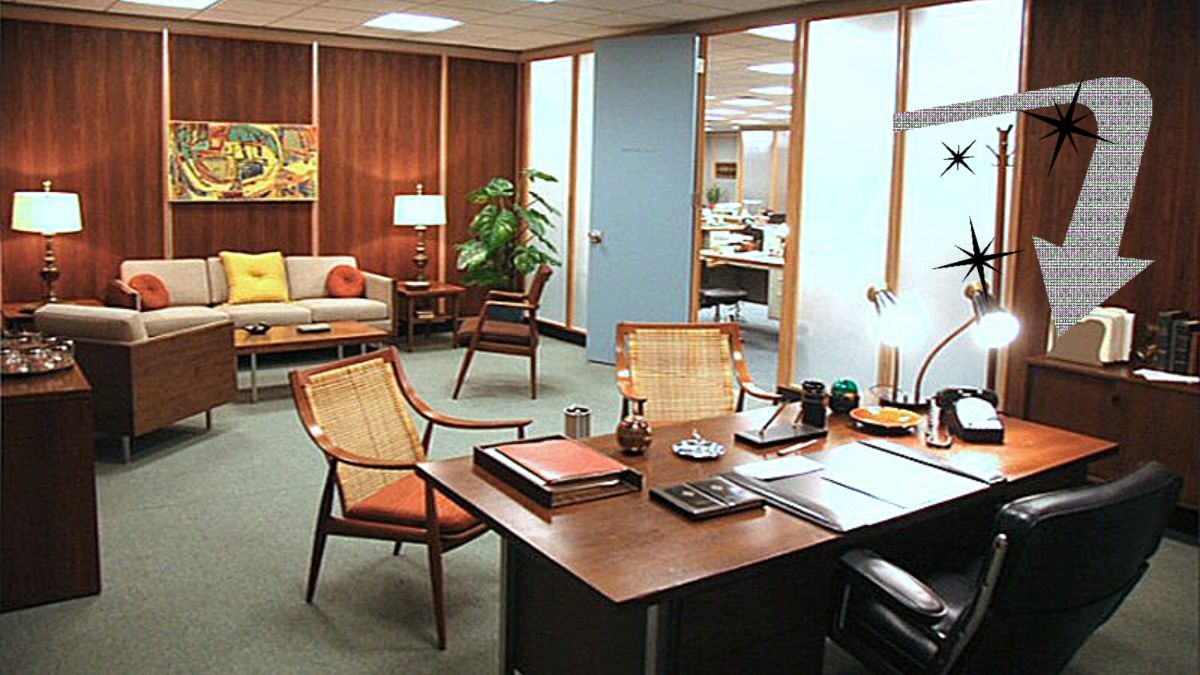
What was once old is new again: mid century modern is back in style. From architecture to furniture, the postwar look is in, and the hype extends all the way to office chairs.
Do you need a mid century modern office chair in your life? If so, there’s plenty to choose from. Your office chair should be tailored to your style, whether you like luxury, utility, or something in between.
That’s why we’ve put together our 10 favorite places to find your ideal mid century modern office chair.
What is mid century modern design?
After World War II, spirits were high in the US, and new technology was taking the country by storm. Mid century modern refers to the design concepts that came about during this time.
As opposed to the frilly, ornate designs of classical furnishings, mid century modern designs are angular, material, and functional. Wood is a common design element, especially teak. Mid century modern furniture may also have materials like glass, vinyl, and metal. Designs are simple and geometric, with bold accent colors to make them pop.
The mid century modern aesthetic never really went away, but it’s made a noted comeback in recent years. Some have chalked it up to Boomer and Gen X nostalgia, others point to mid-century-set shows like Mad Men and The Marvelous Mrs. Maisel.
Why should I buy a mid century modern office chair?
Mid century modern is the perfect fusion of style and utility. If you want to cultivate an office space that commands respect without being ostentatious, mid century modern is the style for you.
When it comes to office chairs, an MCM one is often made with sturdy wood and vinyl. They combine the ergonomics of a modern office chair with old-fashioned grace.
If you’re concerned with utility and utility only, a more bog-standard office chair may suit you. But a mid century modern office chair is great for someone who wants to wow colleagues with a mature, thoughtful business space.
Where can I get a mid century modern office chair?
1) Wayfair
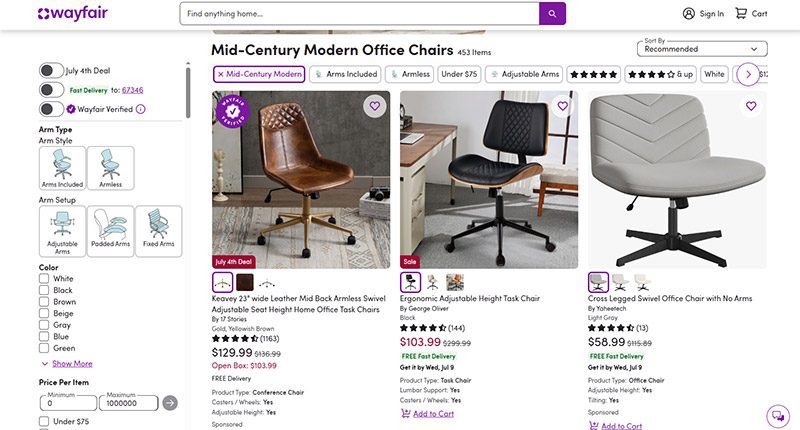
When it comes to furniture, Wayfair offers the best of both worlds. Their goods, including their mid century modern office chairs, are stylish and affordable. You can get a sturdy task chair for less than $100 or a more distinguished seat for less than $350.
MCM office chair examples: Dovray ($126), Bradford ($139), Lithonia ($133)
2) France & Son
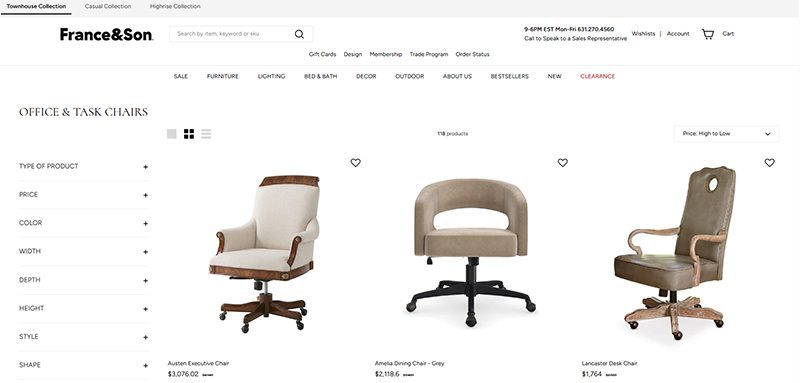
Wayfair’s chairs are affordable, but France & Son is the perfect option for luxury shoppers. Their mid century modern office chairs are robust and sleekly designed. If you dress to impress and enjoy the finer things in life, these are the chairs for you.
MCM office chair example: Brooks ($695)
3) Houzz
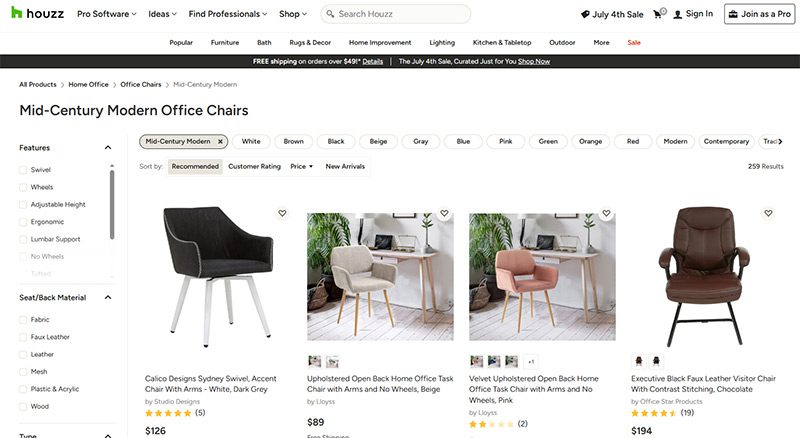
Started as a community for people to share home decor tips, Houzz has become a great ecommerce platform for finding stylish furniture. They’re more known for home decor than desk chairs, but they have plenty of great, affordable finds if you know where to look.
MCM office chair examples: Arvilla ($173), Rathburn ($259)
4) Laura Davidson
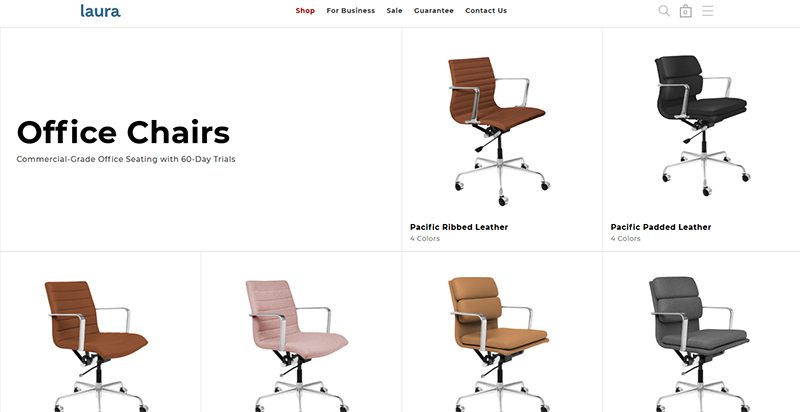
The Laura Davidson collection offers a fairly limited selection of classic office furniture. Still, there’s a reason they’re trusted by big-wigs like Apple, Disney, and Salesforce. Their chairs are sturdy and beautifully designed, reimagining classic Eames and Knoll designs.
MCM office chair examples: Rockefeller ($275), SOHO II Soft Pad ($450)
5) Icons of Manhattan

Icons of Manhattan has a simple philosophy: do one thing, and do it right. Their office chairs are handcrafted from premium materials and tailored to a mid-century modern style. If you want that Mad Men energy in your office (hopefully with a lot less angst), these are the chairs for you.
MCM office chair example: Ribbed Medium ($219)
6) Amazon
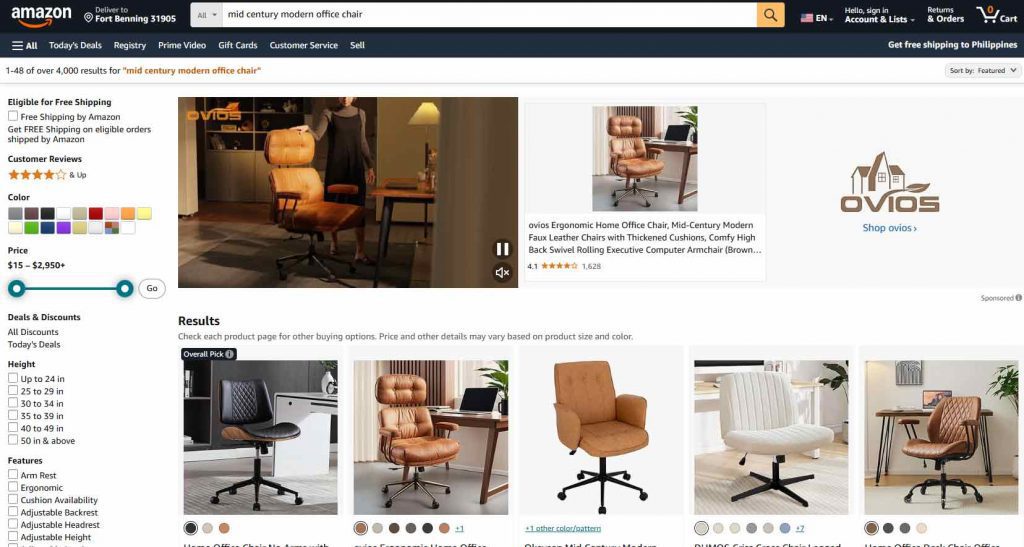
Yes, the internet’s premier shopping destination has a robust collection of mid century modern office chairs. Like with most products, their selection of seats is vast and can be hit or miss. Still, they’ve got stunning chairs available for any style, whether you care about comfort, class, or ergonomics.
MCM office chair examples: IDS Home Modern ($219), Art Leon MCM Swivel ($139)
7) AllModern
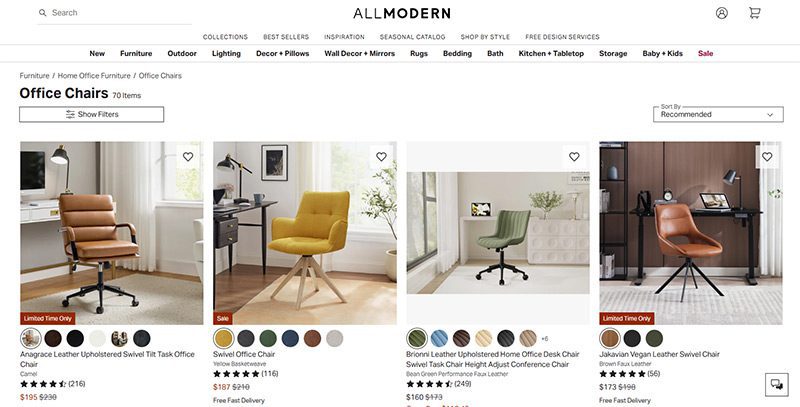
AllModern’s collection of desk chairs and other furniture truly embodies the mid century modern spirit. Their work is tight, angular, and functional above all. They’re part of the Wayfair family and they traffic in a number of modern styles, but their sleek chairs are perfect for any mid century modern space.
MCM office chair examples: Frederick ($229), Kealey ($349)
8) Overstock
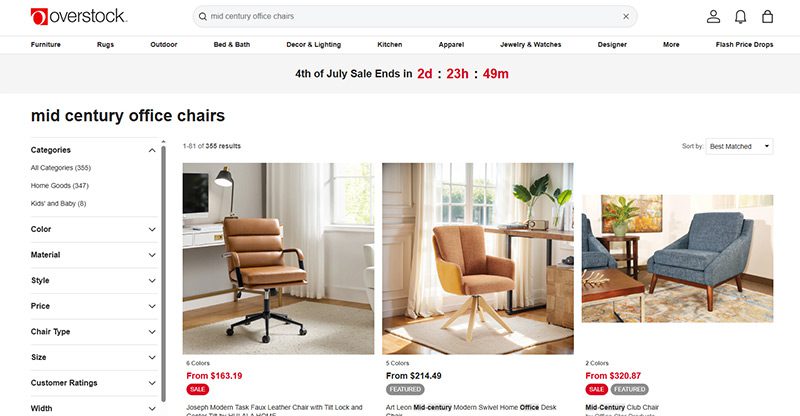
Overstock is known as a one-stop shop for quality home goods at sub-wholesale prices. If you want a spiffy mid century modern office chair that won’t break the bank, they’re the first place to look. While they’re somewhat less reliable than the more upscale platforms on this list, their selection is massive.
MCM office chair example: Joseph Modern ($163)
9) Walmart
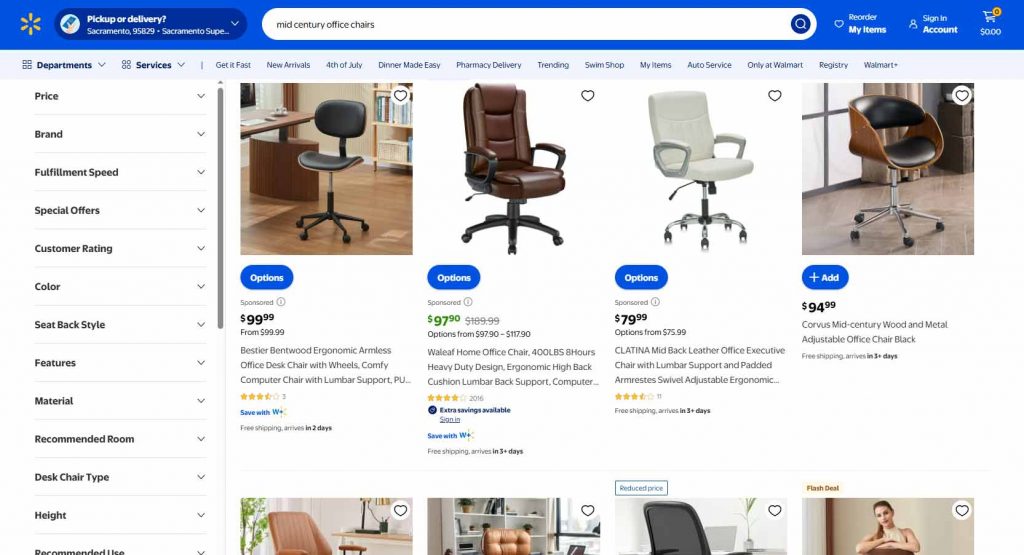
Hayneedle’s selection of mid-century modern office chairs falls somewhere between the minimal Laura Davidson and the endless Amazon catalog. Their array of mid-century designs is affordable and versatile, with chairs that match almost any style. While they may be part of the Walmart family, these chairs are anything but second-rate.
MCM office chair example: Waleaf ($97)
10) Target
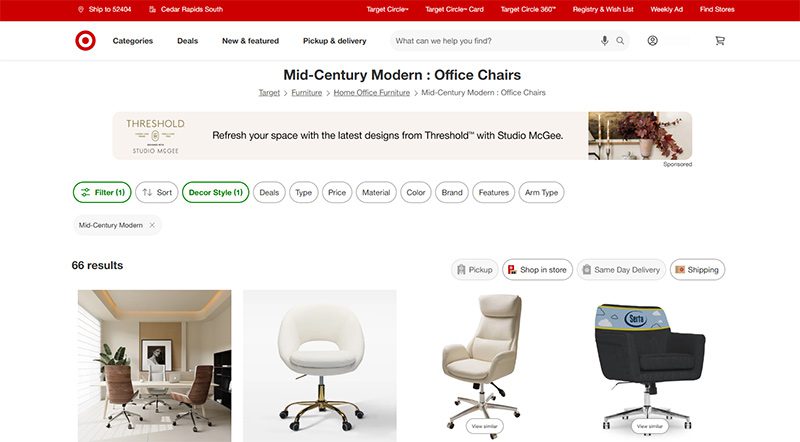
Why splurge when you can save? As usual, Target is a hidden gem, offering a sturdy selection of mid century modern office chairs for some of the cheapest prices out there. Many of the chairs they offer are from the same designers as these other stores—Christopher Knight, LumiSource, Armen Living, etc.—at reduced prices.
MCM office chair example: Lombardi ($136)

A quality payroll service is one of the most invaluable tools any entrepreneur can have. Whether you’re a small business owner or an HR manager, paying your employees on time is crucial. This makes choosing a service even more weighty, after all, it is a heavy administrative burden. The good thing is, you can outsource this duty to an online payroll processor.
According to statistics, 49% of workers begin a new job search after just two paycheck errors, and with 65% of workers living paycheck to paycheck, it’s more important than ever to ensure an efficient, effective payroll process.
These services can save you precious time and mitigate potential issues. To make it easy for you to choose, we listed the best online payroll services for 2025.
Top 5 Online Payroll Services
Gusto
Gusto is a great option for both new and experienced payroll administrators, boasting an incredibly clean user interface and a first-rate payroll setup. Gusto lets you manage your employee’s time off (vacation and sick pay), company health insurance, and worker’s comp. Gusto offers excellent mobile access, too. This allows employees to manage aspects of their Gusto profiles, view payday insights, and access Gusto Wallet financial tools.
Gusto offers four tiers of membership, the most affordable of which is the Contractor’s Only plan, which offers unlimited U.S.-based and global contractor payments, supporting more than 100 countries, plus 1099 creation and filing at a rate of $6 per person per month with no base price.
The other three are Simple, Plus, and Premium. Here’s a deeper look into each plan:
Simple
Price:
$40/mo + $6/mo per person
Plan details:
- Full-service single-state payroll including W-2s and 1099s
- Employee profiles and self-service
- Basic hiring and onboarding tools
- Gusto-brokered health insurance administration
- Employee financial benefits
- Payroll and time-off reports
- Custom admin permissions
- Integrations for accounting, time tracking, expense management, and more
Plus
Price:
$80/mo + $12/mo per person
Plan details:
(All Simple plan features +)
- Full-service multi-state payroll including W-2s and 1099s
- Next-day direct deposit
- Advanced hiring and onboarding tools
- PTO management and policies
- Time tracking and project tracking
- Workforce costing and custom reports
- Team management tools
- Full support
Premium
Price:
Bespoke pricing, reach out for a personalized quote
Plan details:
(All Plus plan features +)
- HR Resource Center
- Compliance alerts
- Access to certified HR experts
- Full-service payroll migration and account setup
- Health insurance broker integration
- R&D tax credit discount
- Waived fees and exclusive pricing
- Performance reviews
- Employee surveys and insights
- Dedicated support
QuickBooks Online Payroll
Founded in 1983, Intuit is a California-based financial software company. Since its inception, Intuit has developed into one of the best-known providers of accounting software. Their online payroll service, QuickBooks, includes the essential features you need to run payroll.
QuickBooks offers three tiers of membership. The least expensive membership covers basic accounting features, such as invoices. For more features, check out the Essentials and Plus memberships. Each plan’s features are as follows:
QuickBooks Simple Start (2025)
- Price: $38/month for 1 user
- Best for: Freelancers and small teams with basic payroll needs
Features:
- Automated bookkeeping
- 5 free ACH bank transfers/mo for bills
QuickBooks Essentials (2025)
- Price: $75/month for 3 users
- Best for: Small businesses needing deeper financial tracking
Features:
- Includes all Simple Start features, plus:
- Recurring invoices
QuickBooks Plus (2025)
- Price: $115/month for 5 users
- Best for: Growing businesses with HR and compliance needs
Features:
- Includes all Essentials features, plus:
- AI-powered profit & loss insights
- Anomaly detection and resolution
- Budgeting
QuickBooks Advanced (2025)
- Price: $275/month for 25 users
- Best for: Established businesses with HR and compliance needs
Features:
- Includes all Plus features, plus:
- Custom user management and permissions
- Custom report builder
- Data sync with Excel
- Revenue recognition
- Forecasting
OnPay
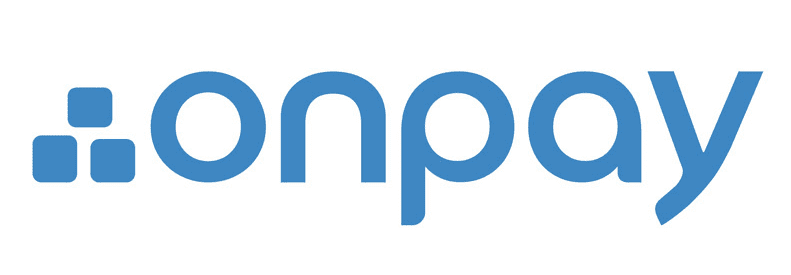
OnPay is a cloud-based full-service payroll processing system capable of running payroll according to a preset schedule, automatically disbursing wages, and calculating and withholding taxes.
OnPay can sync up with several other software your team is already using, making it easy to integrate the service into your team’s system. Another benefit of OnPays model is the simple, transparent pricing structure. No tiers; just one base rate.
Pricing:
$49/mo + $6/mo per employee
SurePayroll

SurePayroll’s award-winning service supports W-2 employees and 1099 contractors. Additionally, it handles 401(k) deductions and manages flexible spending accounts (FSA) and health savings accounts (HSA).
SurePayroll also offers a mobile app— available on both Apple and Android devices.
SurePayroll offers live support through its United States-based support team through chat, email, or phone.
Small Business Payroll
- Price: No Tax Filing: $20/month + $4 per employee, Full Service: $29/month + $7 per employee
- Best for: Small businesses and startups
Features:
- We file and deposit your federal and state taxes!
- Run payroll in 3 simple steps
- Schedule payroll to run automatically
- Unlimited payroll runs and free 2-day direct deposit
- Reports and pay stubs are available online 24/7
- Supports W-2 employees and 1099 contractors
Nanny & Household Payroll
- Price: Full-Service Household, $39/month, includes 1 employee, $10 per additional employee
Best for: Homeowners
Features:
- Signature-ready Schedule H
- We file & deposit your federal and state taxes!
- Run payroll in 3 simple steps
- Schedule payroll to run automatically
- Unlimited payroll runs and free 2-day direct deposit
- Reports & paystubs available online 24/7
- Supports W-2 employees & 1099 contractors
Be sure to choose a payroll service that works for your business, and provides you with the peace of mind that comes with a reliable bookkeeping system. Your employees will thank you.

Merck is currently in talks to acquire Seagen, a biotech company. The Wall Street Journal reports that the transaction is valued at $40 billion. And what happens if Merck acquires Seagen, and how would this acquisition benefit cancer research and treatment? Read more about the Merck Seagen buyout here.
Merck Seagen Buyout
Merck and Seagen are still deciding on their share prices. So far, talks have yet to reach an agreement on $200 per share. Both companies want to settle and finalize their deals before Merck announces its quarterly earnings on July 28. At the time of writing, Seagen’s stock was at $176.19.
With an estimated market value of $235 billion, Merck is looking to expand its presence in the cancer treatment space. The Merck Seagen Buyout could play a major role in that strategy. Since Seagen specializes in targeted cancer therapies, the acquisition would give Merck access to a broader range of oncology products.
Shareholder reactions to the new deal are overwhelmingly positive, and the stocks have been up since talks about the deal have been made public.
But this is not the first time that Merck and Seagen have made the news. Back in 2020, they collaborated because of cancer treatments. Seagen has a drug conjugate (ladiratuzumab vedotin) which would be used in conjunction with Merck’s Keytruda.
Merck reveals that Keytruda is its highest-selling product. It’s immunotherapy for cancer.
And this deal could help Merck offset the possibility of reduced sales because it will lose patent protection in 2028.
As promising as this deal is, there could be scrutiny from antitrust officials since there might be a litigation case from the Federal Trade Commission or Justice Department.
The Seagen buyout isn’t the only deal Merck has made recently. They’ve been busy closing another deal, but with Orion too.
Seagen
As a cancer biotech company, Seagen has therapies to ensure that patients benefit from the treatment and reduce any adverse side effects. Their treatments involve the therapy attacking tumors with toxins.
Merck partnering with Seagen isn’t a bad idea considering that Seagen made $1.4 billion in sales in 2021, most of it coming from Adcetris and Padcev (a treatment for urothelial cancers).
Merck-Orion Deal
In the middle of the Merck Seagen Buyout, Merck has recently partnered with Orion for the ODM-208 and other drugs. These drugs are related to the production of steroids. Orion found how it can combat hormone-dependent cancers and further developed this inhibitor.
Their deal includes that they should develop ODM-208 and promote it to the public together. And Orion will receive a $290 million payment from Merck.
Although they’re co-developing and marketing the new inhibitor, Orion will oversee the manufacturing side.
Co-developing the ODM-208 can help Merck with its current research and treatments for prostate cancer. President and CEO of Orion, Timo Lappalainen, says that this partnership will benefit Merck’s goals of treating cancer worldwide.
Other Ventures: Merck’s Role in the Pandemic
You may have heard about COVID-19 pills, which are a form of treatment for those diagnosed with mild to moderate COVID-19. Merck introduced an antiviral COVID-19 pill to the public. The name: Molnupiravir.
The COVID-19 pill is not a replacement for a vaccination. Instead, it stops the replication of the COVID-19 genetic code and keeps the patient out of the hospital. Not yet FDA-approved, Molnupiravir has been authorized for emergency use since December 23, 2021.
And for other stories, read more here at Owner’s Mag!

Should I Buy an Electric Scooter? What You Can Learn

Best Workflow Mapping Tools for Smarter Business Processes

Top White Label Marketing Tools for Agencies: Our 10 Best Picks

Virtual Reality Exhibit Carne Y Arena: The Refugees’ Plight

Top 10 Podcast Editing Software Applications for Beginners

What Is Tiktok Pink Sauce? The Viral Condiment, Explained

Did You Drop Your Smartphone in The Ocean? Here’s How to Retrieve It

Top White Label Marketing Tools for Agencies: Our 10 Best Picks

History of the NBA: The Success Behind the Big League

Demio SaaS 2025 Review: Features, Pricing, Pros & Cons

Did You Drop Your Smartphone in The Ocean? Here’s How to Retrieve It

Virtual Reality Exhibit Carne Y Arena: The Refugees’ Plight

Best Workflow Mapping Tools for Smarter Business Processes

Gift Guide: 25 Best Gifts for Women for All Occasions
Trending
- Technology17 hours ago
Top White Label Marketing Tools for Agencies: Our 10 Best Picks
- Technology22 hours ago
Virtual Reality Exhibit Carne Y Arena: The Refugees’ Plight
- Technology16 hours ago
Best Workflow Mapping Tools for Smarter Business Processes
- Technology23 hours ago
Top 10 Podcast Editing Software Applications for Beginners
- Lifestyle6 hours ago
Should I Buy an Electric Scooter? What You Can Learn

















